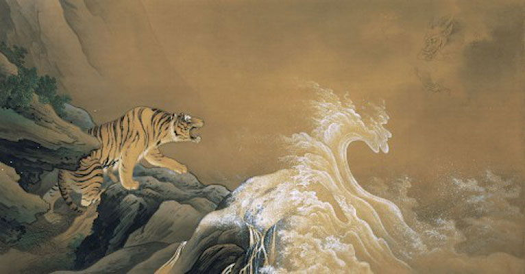Background Information
This is the
Primavera, also known as "Spring," by Sandro Botticelli. The painting was created in Florence, Italy,
circa 1480. It is 207 x 319 cm and is tempera grassa on wood.
The painting depicts nine figures from classical mythology. To the right, Zephyrus is reaching for Chloris. Chloris transforms into Flora, the spring goddess. In the center of the painting is Venus, the goddess of love and beauty, with Cupid directly above her. Farthest left is Mercury, with the Three Graces dancing next to him.
This is the
largest mythological painting of the Early Renaissance, and it was commissioned by the Medici family. There have been many interpretations of the painting by scholars over the years. The
Primavera and the famous
Birth of Venus were created by Botticelli as companion paintings and are meant to be displayed together. The central figure in both paintings is Venus, who had just arrived on Earth in the
Birth of Venus. In the
Primavera, she has reached a mature state, surrounded by a lush meadow.
Italian Renaissance Humanism
Humanism focuses on the idea that an individual's faith is not completely governed by institutional religion. This way of thinking inspired artists of the time to step away from the influence of the clergy. Humanism was about the pleasures of the social values of the present, rather than the spiritual values that prepared for a future life. As this was the same mindset that contributed to successes during the classical era, it was believed that employing this method of thought would revive Italian society. Due to this, the subject matter of art grew from being exclusively Christian to including themes from classical mythology.
The
Primavera is encompassed entirely of mythological figures. At the time, Botticelli's use of mythological subjects was
groundbreaking. According to art critic Jonathan Jones, the
Primavera "was one of the first large-scale European paintings to tell a story that was not Christian, replacing the agony of Easter with a pagan rite. The very idea of art as a pleasure, a not a sermon, began in this meadow." Botticelli's major departure from the typical Christian subject matter in this artwork is a perfect example of the humanist method of thought.
The Italian Renaissance also saw the emergence of popularity in artworks featuring nude figures. This relates to humanism because humanist thinkers focused on the individual and their beauty and importance. Additionally, anatomical details appealed to Renaissance Christians because they understood that humanity was created
in the image of God. The
Primavera emphasizes the human figure.
Analysis
The feel of this artwork is mysterious and fantastical. It is not entirely clear what each of the figures is doing and why, leaving much room for interpretation. Venus is centered but appears to be further away than the other figures. It feels as if this is her orange grove and everyone else is visiting.
One of the best features of this painting is the texture. The Three Graces and Chloris are wearing nearly translucent dresses, an effect achieved by masterful use of texture. The folds on the clothing of Venus, Mercury, and Flora also provide lovely detail. Further, the detail in the vegetation almost makes one feel like they could smell the oranges.
The colors and tones used offer a sense of harmony and tranquility. The darker tones of the surrounding foliage provide a feeling of peaceful isolation in the forest. All of the figures have a softness to them, except for Zephyrus on the right, who has a blue tint that makes him appear to be an intruder.
It would be amazing to see this piece up close in an art gallery to be able to view all of the little details in person.
References
Graham, Heather. “Humanism in Italian Renaissance Art (Article).” Khan Academy, Khan Academy, www.khanacademy.org/humanities/renaissance-reformation/early-renaissance1/beginners-renaissance-florence/a/humanism-in-italian-renaissance-art. Accessed 13 Feb. 2024.
“Italian Renaissance Art - Humanism.” Italian Renaissance Art - Humanism, www.artyfactory.com/art_appreciation/art_movements/italian-renaissance/italian-renaissance-art-humanism.html. Accessed 13 Feb. 2024.
Parenti, Daniela. “Spring by Botticelli.” Uffizi Galleries, 22 Nov. 2023, www.uffizi.it/en/artworks/botticelli-spring#characteristics.
“Renaissance Humanism - Modern Art Terms and Concepts.” The Art Story, www.theartstory.org/definition/renaissance-humanism/. Accessed 13 Feb. 2024.
“Sandro Botticelli Primavera (Allegory of Spring).” Primavera by Sandro Botticelli, www.historylink101.com/art/Sandro_Botticelli/pages/09_Primavera_jpg.htm. Accessed 13 Feb. 2024.


Sandro Botticelli's La Primavera is an excellent example of Renaissance painting influenced by humanism. It's a great choice for a renaissance blog. It is also one of my favorite pieces of art. The incredibly detailed landscape is unique and unparalleled in execution. In this painting, Sandro Botticelli has accurately and meticulously depicted 138 species of different plant species, adding to the painting's iconography.
ReplyDeleteThis comment has been removed by the author.
ReplyDeleteYou chose an amazing piece from the humanism era. My eyes were drawn to the dark trees and then to the people. The peaches in the trees bring life into such dark leaves and branches, while the mushrooms in the dark green moss draw life from below. This is an exquisite piece from the Renaissance era. The spirituality and peaceful emotion can be felt within this piece.
ReplyDelete